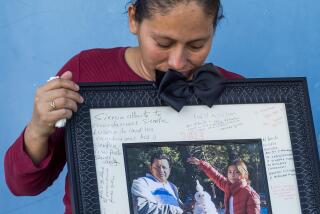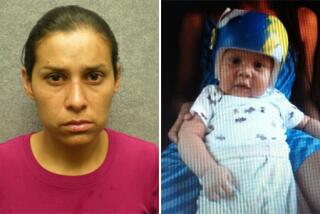Drunk-Driver Murder Conviction Upset : Justice: The appeals court decision draws sharp criticism from the man whose wife and three children died in the collision.
A state appellate court Monday reversed the murder conviction of a drunk driver whose car struck another, killing a Fullerton mother and her three children in 1984.
The 4th District Court of Appeal in Santa Ana said it has ordered that the jury conviction of Michael W. Reding, now 31, automatically be reduced to vehicular manslaughter unless the Orange County district attorneyâs office decides within 30 days to retry him for murder. In a unanimous opinion, the justices said jurors should never have heard about Redingâs possible cocaine use.
âThe prejudicial effect of drug use on a jury cannot be overestimated in todayâs war-on-drugs climate,â Justice Thomas F. Crosby Jr. said.
The decision drew strong criticism from Robert F. Trueblood, whose wife and three children died.
âI obviously feel the appellate court has made a tremendous mistake,â he said. âThe . . . court is not really interested in justice being served. They are just dealing with legal technicalities in court. . . .
â . . . Iâve followed the matter from Day 1. Iâve been to court every day. I have witnessed the whole thing. The matter should be appealed to the state Supreme Court or retried. The D.A. should make sure that justice is done.â
âMy inclination right now is to think we will retry him for murder,â said Deputy Dist. Atty. Thomas M. Goethals, who is in charge of the writs and appeals section. âBut itâs premature to say just what we will do.â
Reding was sentenced to 15 years to life in 1986 after he became the first drunk driver in Orange County to be convicted of second-degree murder in a vehicle collision. The trial became a focal point for groups seeking tougher jail terms for drunk drivers.
Reding admitted that he had been drinking on the night of the Oct. 23, 1984, head-on collision on State College Boulevard, near Bastanchury Road, in Fullerton. The collision killed the other driver, Pamela Trueblood, 36, and her children, Eric, 11; Kerry, 9, and Scott, 8. Two other children in the Trueblood car were seriously injured but survived.
Reding testified that he had just changed a tape on his car stereo when he looked up and saw the approaching car. Witnesses said Reding was driving at more than 70 m.p.h. in a 45 m.p.h. zone when his car struck the Trueblood car.
Redingâs lawyers did not deny that their client was drunk. But a hotly disputed issue was whether he had also used cocaine the day of the crash.
The prosecutor, Mike Jacobs, who has since left the district attorneyâs office, agreed before the trial not to raise the cocaine issue unless the defense did something to make it necessary in rebuttal.
But Jacobs brought it up when cross-examining Reding, claiming that it was a legitimate issue for impeaching Redingâs testimony that he was able to drive safely.
Superior Court Judge James L. Smith agreed to allow the evidence for a limited purpose: to determine if cocaine might have led to Redingâs sketchy memory of the crash.
On rebuttal, Smith allowed Jacobs to call a drug expert to the stand who implied that chemicals found in Redingâs system showed that he had probably taken cocaine the day of the crash. Reding denied it.
Then, in closing arguments, Jacobs made the possible cocaine use a key issue--not only telling jurors that the cocaine made Reding more dangerous but speculating that Reding was probably on his way to buy more at the time of the crash.
âThe prosecutor effectively sank the defendant in a sea of white powder,â Justice Crosby stated.
While Crosby called Jacobs overzealous, he also attacked defense attorney Heidi Mueller for not raising more objections than she did over the cocaine issue.
Reding, an engineer at Northrop Corp., said in interviews before his conviction that he thought he should be punished for what he had done but that he thought murder was too steep a charge.
Goethals said a resentencing on four counts of vehicular manslaughter ordered by the appellate court could amount to a term of as much as 15 years. But the difference is, it would be a specific sentence, instead of the broader 15 years to life that a murder conviction carries, he said.
Times staff writer Davan Maharaj contributed to this story.
More to Read
Sign up for Essential California
The most important California stories and recommendations in your inbox every morning.
You may occasionally receive promotional content from the Los Angeles Times.










